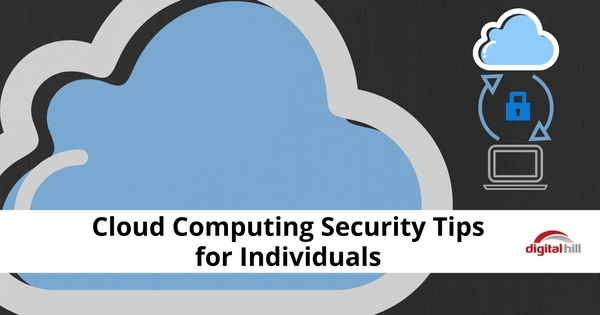Cloud Computing Security Tips for Individuals

Cloud services are being increasingly used today by both corporate and individual users. While corporate users commonly use CRM and Marketing applications like Salesforce and InfusionSoft from the cloud, individuals use applications like Gmail and Dropbox.
Over the past few years, there has been a gradual shift to using applications hosted in the cloud. Consumers are increasingly feeling comfortable not only tapping applications off the cloud but also storing even critical data, storage and documents on the cloud.
But security does remain an area of concern. According to the Cloud Security spotlight report, around 22% of information security professionals see security as a shortcoming for cloud-based solutions. And the Cloud Adoption Practices survey indicates that concerns about the security of data are among the top challenges holding back cloud projects with 73% of the survey participants feeling that way.
While cloud providers have in place extremely sophisticated techniques to ensure data and application security, it is recommended that end users be aware of some ways and methods which would ensure a safe experience while using cloud-based applications. Here are some of the top safety tips while using the cloud.
Ensure Data is Encrypted Before Upload
There are a few elements to this:
- You should always ensure that you initiate your connections to the cloud through an encrypted connection, i.e. https. Please ensure that your browser supports encryption of a sufficiently high strength.
- One simple way to encrypt data is to zip and encrypt the files with a password. There are a number of software applications available which enable you to do this. What you need to do here is, to use the protect with a password option while creating the archive before moving the archive to the cloud.
- Once you download a file from a cloud-based service, you can decrypt it using the same utility.
- There are other programs available such as TrueCrypt which are more sophisticated and give you a bigger choice of algorithms apart from the popular AES.
Ensure Encrypted Data is Stored in the Cloud
It is not enough that data is encrypted when uploading to or downloading from the cloud. It should also be encrypted when stored in the cloud site. To verify this, you should always study the terms of service mentioned in the agreement with the provider.
Once you are encrypting and sending out data, it should be stored in the same form, not decrypted and stored. Ideally speaking, you should be the only to have the encryption keys; however, it should be stored in the encrypted format a minimum. Similarly, when downloading data, it should not be that the data is decrypted before being sent to your end.
Understand how Folder and Document Sharing Options Work
Most providers permit you to set access permissions to read and update at the folder level in the cloud location. It is recommended that you get to know the details of how these permissions work. Since cloud locations lend themselves somewhat easily to document and link sharing, people often allow these permissions to be set by default. This can be tricky since it can open up your files to the possibility of data theft.
Here are a few recommended practices:
- When you upload files to the cloud location, observe what kind of privacy settings are being applied by default
- Get familiar with the privacy-related settings and how to apply them correctly.
- Consider using a VPN or at least a free VPN service to ensure your connection is secure.
- Ensure that each time you upload data, it is stored off with the correct permissions.
- Also, observe what permissions are being set to files or documents that are downloaded from the cloud location. Sometimes permissions can be reset by cloud applications when the download happens.
Understand Provisions to Handle Data Loss, Theft, and Hacking
One of the aspects that are often ignored when signing up for cloud-based services is the understanding of provisions related to data loss, theft and hacking. When you sign up for the contract with a cloud-based provider, you should have a close look at these provisions. Some contracts come bundled with insurance that covers the risk of data theft. You should always prefer vendors who provide you with bundled insurance cover against the risk of data loss and theft. If not, have a look at the options available in the marketplace and avail an insurance policy.
Some contracts come bundled with insurance that covers the risk of data theft. You should always prefer vendors who provide you with bundled insurance cover against the risk of data loss and theft. If not, have a look at the options available in the marketplace and avail an insurance policy.
To minimize the chances of hacking, always work only with cloud providers who have had their processes certified for information security and with ISO or CMM. While you can never prevent hacking from happening, you should at least take measures to ensure that the risk of hacking is minimized.
Backup Data at Regular Intervals
One more tendency, be it by corporate or individual users, is to get a certain sense of complacency after signing up for cloud-based services. While the same users would have been periodically backing up data, users have a tendency to let their guard down once they sign up for cloud-based services.
It is important to continue the practice of backing up even after signing up for cloud-based services. This would ensure that emergency backups can be tapped if there is a failure in the cloud-based services.
 Bio: Mauricio is the lead Cloud expert at Cloudwards.net, a data and user feedback driven comparison engine for cloud storage, online backup and VPN apps and services. In addition, He also loves producing educational videos and reviews to help people get the best services for their needs. Get in touch with him on LinkedIn.
Bio: Mauricio is the lead Cloud expert at Cloudwards.net, a data and user feedback driven comparison engine for cloud storage, online backup and VPN apps and services. In addition, He also loves producing educational videos and reviews to help people get the best services for their needs. Get in touch with him on LinkedIn.
